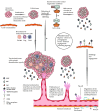Blocking Tumoral Angiogenesis VEGF/VEGFR Pathway: Bevacizumab-20 Years of Therapeutic Success and Controversy
- PMID: 40227654
- PMCID: PMC11988089
- DOI: 10.3390/cancers17071126
Blocking Tumoral Angiogenesis VEGF/VEGFR Pathway: Bevacizumab-20 Years of Therapeutic Success and Controversy
Abstract
The "angiogenesis switch"-defined as the active process by which solid tumors develop their own circulation-plays an important role in both tumoral growth and propagation. As the malignant tumor grows and reaches a critical size, the metabolic needs as a function of an ever-increasing distance to the nearest emergent blood vessel, can no longer be covered by the microenvironment of the peritumoral tissue. Although a relatively discrete process, the "angiogenic switch" acts as a limiting stage of tumoral development present from the avascular hyperplasia phase to the vascularized neoplastic phase, providing support for tumor expansion and metastasis. Over time, research has focused on blocking the angiogenetic pathways (such as VEGF/VEGFR signaling axis) leading to the development of targeted therapeutic agents such as Bevacizumab. Objectives: We conducted a review of the molecular principles of tumoral angiogenesis and we tried to follow the history of Bevacizumab from its first approval for human usage 20 years ago to current days, focusing on the impact this agent had in solid tumor therapy. A comprehensive review of clinical trials pertaining to Bevacizumab (from the era of the preclinic trials leading to approval for human usage, to the more recent randomized trial focusing on combination targeted therapy) further details the role of this drug. We aimed to establish if this ancient drug continues to have a place in modern oncology. Conclusions: Bevacizumab, one of the first drugs targeting tumoral microenvironment, remains one of the most important oncologic agents blocking the VEGF/VEGFR angiogenic pathway. otherwise, history of 20 years marked by numerous controversies (ranging from methodological errors of clinical trials to withdrawal of approval for human usage in breast cancer patients, from discussions about severe side effects to resistance to therapy and limited efficacity), Bevacizumab continues to provide an optimal therapeutic option for many solid tumors that previously had little to no means of treatment, improving otherwise bleak outcomes. Even in the era of personalized precision oncology, Bevacizumab continues to be a key element in many therapeutic regimens both as monotherapy and in combination with newer targeted agents.
Keywords: Bevacizumab; VEGF; VEGF receptors; angiogenesis; angiogenesis inhibitors; molecular mechanisms; resistance to antiangiogenetic drugs.
Conflict of interest statement
The authors declare no conflicts of interest.
Figures


Similar articles
-
Monoclonal antibodies targeting vascular endothelial growth factor: current status and future challenges in cancer therapy.BioDrugs. 2009;23(5):289-304. doi: 10.2165/11317600-000000000-00000. BioDrugs. 2009. PMID: 19754219 Review.
-
Bevacizumab (Avastin®) in cancer treatment: A review of 15 years of clinical experience and future outlook.Cancer Treat Rev. 2020 Jun;86:102017. doi: 10.1016/j.ctrv.2020.102017. Epub 2020 Mar 26. Cancer Treat Rev. 2020. PMID: 32335505 Review.
-
Role of anti-angiogenesis agents in treating NSCLC: focus on bevacizumab and VEGFR tyrosine kinase inhibitors.Curr Treat Options Oncol. 2007 Feb;8(1):15-27. doi: 10.1007/s11864-007-0022-4. Curr Treat Options Oncol. 2007. PMID: 17634832 Review.
-
The role of antiangiogenetic agents in the treatment of breast cancer.Curr Med Chem. 2011;18(33):5022-32. doi: 10.2174/092986711797636072. Curr Med Chem. 2011. PMID: 22050750 Review.
-
Angiogenesis in cancer: Anti-VEGF escape mechanisms.Transl Lung Cancer Res. 2012 Mar;1(1):14-25. doi: 10.3978/j.issn.2218-6751.2011.11.02. Transl Lung Cancer Res. 2012. PMID: 25806151 Free PMC article. Review.
Cited by
-
Mechanisms of Cancer Cell Lymphatic Endothelialization in Tumor Lymphangiogenesis and Metastasis: A Comprehensive Review.J Inflamm Res. 2025 Aug 9;18:10741-10750. doi: 10.2147/JIR.S535351. eCollection 2025. J Inflamm Res. 2025. PMID: 40809467 Free PMC article. Review.
-
Microenvironment and Tumor Heterogeneity as Pharmacological Targets in Precision Oncology.Pharmaceuticals (Basel). 2025 Jun 18;18(6):915. doi: 10.3390/ph18060915. Pharmaceuticals (Basel). 2025. PMID: 40573308 Free PMC article. Review.
-
Bardoxolone Methyl: A Comprehensive Review of Its Role as a Nrf2 Activator in Anticancer Therapeutic Applications.Pharmaceuticals (Basel). 2025 Jun 27;18(7):966. doi: 10.3390/ph18070966. Pharmaceuticals (Basel). 2025. PMID: 40732256 Free PMC article. Review.
-
Evaluation of nanoencapsulated bevacizumab combined with paclitaxel in a colorectal cancer xenograft model.Drug Deliv Transl Res. 2025 Aug 14. doi: 10.1007/s13346-025-01941-6. Online ahead of print. Drug Deliv Transl Res. 2025. PMID: 40813748 No abstract available.
References
Publication types
LinkOut - more resources
Full Text Sources
Research Materials

